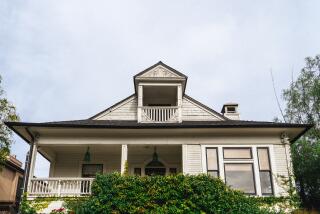Hotels Using Ozone Units to ‘Purify’ Room Air : Trends: Portable systems are being used to neutralize odors and freshen smoke-filled rooms.
- Share via
Ozone purifying units are increasingly being used in hotel and motel rooms to “purify” the air and remove stale odors caused by food and beverages, tobacco smoke, mold, mildew and other elements.
About the size of a lunch pail, the units are small enough to be carried on a maid’s cart.
After a hotel room has been cleaned, the unit is plugged into an outlet in the unoccupied room and allowed to run for 15 to 20 minutes. Generally, the housekeeping staff leaves to clean the next room and then goes back to get the machine for use in the room that has just been cleaned.
Ozone is a naturally occurring gas found most abundantly in the upper level of the atmosphere, and is best known for its ability to protect the Earth from the sun’s ultraviolet rays.
According to Rainbow Technology and Zontec Air Purification Systems, manufacturers of ozone purifying units, the gas has been used since 1904 as a method of purifying drinking water in various cities around the world, including New York, Chicago, London, Paris, Frankfurt and Montreal. “Ozone can be used as a sterilant for air and water, and it’s generally a very safe kind of sterilant since it dissipates quickly,” said William Fairbrother of the New York-based Scientists for Public Information.
According to their manufacturers, the ozone units create controlled levels of the gas that duplicate the levels found outside and serve to neutralize the source of room odors.
“Ozone reacts to the odor in the air and neutralizes it, leaving oxygen as the byproduct,” Fairbrother said.
Ozone purifying units are now being used by a number of major hotel chains nationwide, among them Hilton, Sheraton, Marriott and Days Inns. Hilton currently uses the units at six of its 250 U.S. hotels, including the Hilton Hawaiian Village in Honolulu, according to spokeswoman Kendra Silverman. And both Hilton and Ramada have plans to make the units available to all of their domestic hotels sometime this year, confirmed Silverman and Ramada spokeswoman Sue Schweller.
Southern California hotels using the ozone purifying units include Sheraton hotels in Universal City, Long Beach, Cerritos, Santa Monica and at LAX, and Marriott hotels in Anaheim, Newport Beach and Irvine.
The ozone purifier gets rid of 99% of a room’s odors, claims Susan Duffy, a spokeswoman for Ogdensburg, N.Y.-based Zontec.
But while extolling the odor-removing virtues of ozone purifying units, manufacturers are quick to add that their products provide no real health advantages.
“We don’t claim any medical benefits,” said Duffy. “However, properties using the ozone purifier don’t have to use chemical deodorizers and aerosol units. When you enter an ozone-purified room, you smell fresh air, not the air freshener.”
A similar sentiment came from Larry Joe Steeley, vice president of Rainbow Technology in Pelham, Ala.: “While tests show that ozone can kill some bacteria and viruses, we don’t make any health-related claims about our units reducing the possibility of contracting illnesses or allergies, since these are medical matters. The great advantage of ozone is that it doesn’t mask odors like air fresheners or chemicals, it actually eliminates them.”
After the ozone purifying machine is unplugged, ozone in the room quickly dissipates. After that, how long the room retains its freshness depends on the guests.
“We recommend that people not stay in the room while our machine is in use as ozone at high concentrations can be an irritant, but the amount released is not dangerous,” said Steeley. “The ozone is gone within 10 minutes after the machine is unplugged, and you just smell a fresh room.”
However, ozone can aggravate allergies, colds and other respiratory ailments. “Some guests, especially children, may be sensitive to the ozone and not even know it,” said Dr. Robert Phalen, a professor in the department of community and environmental medicine at UC Irvine.
According to company claims, the Zontec ozone purifying unit, operating in a standard hotel room for a 15-minute period, produces an average ozone level of approximately .03 parts per million, which is about 10% of the short-term exposure standard established for hotel workers by the Occupational Safety and Health Administration of the U.S. Department of Labor.
“If the purifiers are used in an unoccupied room, and the amount of ozone released meets OSHA standards, the units are safe and effective,” said Phalen. “However, I recommend that the units be carefully monitored about every six months by an industrial hygienist, and that hotels post signs while rooms are being purified.”
Ozone-producing units also are used, as hotel spokesmen describe it, to convert smoking rooms to nonsmoking rooms, a process that takes about an hour. If a guest smokes in a nonsmoking room, it normally takes 20 to 30 minutes to sanitize the room and return it to nonsmoking status.
While ozone purification products for hotel rooms have been in the marketplace since the early 1980s, their use has increased in recent years due to a more environmentally conscious public and the demand by hotel guests for nonsmoking rooms.
“Many hotel chains now want 40%-50% of their rooms to be nonsmoking to correspond to what the public wants, whereas this percentage on an industry-wide basis was about 10% only a few years ago,” said Steeley.
More to Read
Sign up for Essential California
The most important California stories and recommendations in your inbox every morning.
You may occasionally receive promotional content from the Los Angeles Times.










